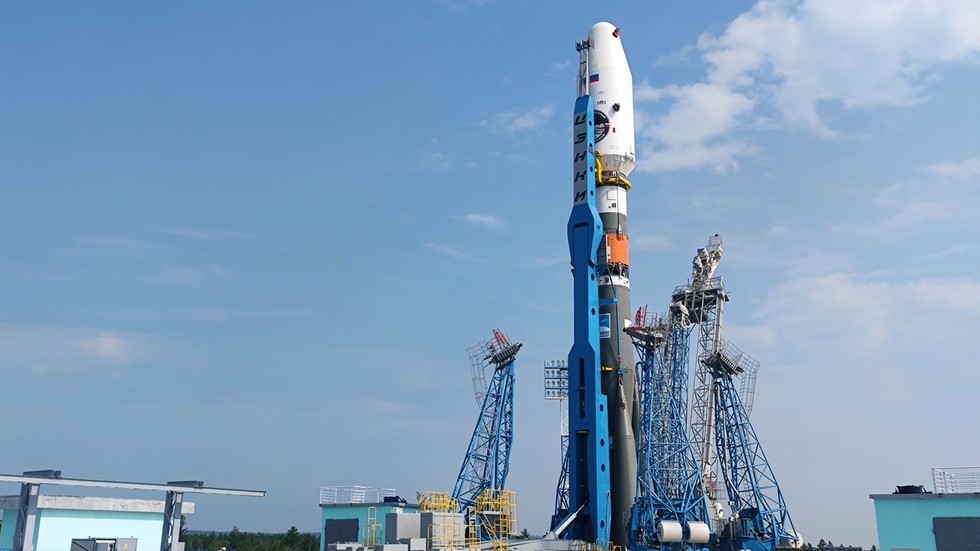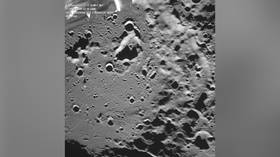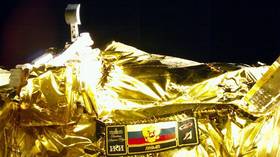
Russia’s historic Luna-25 probe crash landed into the Moon during the summer. The failure has kicked off a debate about the country’s space priorities
By Oleg Barabanov, Programme Director of the Valdai Club

FILE PHOTO: The Soyuz-2.1b carrier rocket with the Fregat upper stage carrying the Luna-25. © Sputnik / Russian Space Agency Roscosmos / RSC ‘Energia’
The space race, which Moscow won back in 1961, was an immense achievement – but the earth’s satellite has posed a tricker challenge.
The term “moon race” appeared long ago, at the dawn of the space age, and from the very beginning it took on a strong geopolitical dimension. It reflected the great – perhaps, in retrospect, very exaggerated – symbolic importance attached to primacy in space. The Soviet Union was the first to put an artificial satellite into orbit, and the first to send a man into the cosmos. The Americans responded, many years later, by landing astronauts on the moon. The very beginning of the American lunar program was once announced with great media pomp by US President John F. Kennedy. His phrase “we choose the Moon” became one of the most famous quotes in history.
What is less well known is that in the same speech Kennedy was probably the first to speak of the need for peaceful cooperation in space, regardless of geopolitics, because exploration was a task for all of humanity. But real cooperation between the USSR and the US in spaceflight began later, during the preparation of the joint Soyuz-Apollo program, which, it seems, coincided with the geopolitical détente of the first half of the 1970s. However, initially, the logic of competition still prevailed.
The Soviet Union’s lunar project, unlike America’s, was not a media event from the beginning. At the time, nothing was reported in the general press about the preparations for a manned mission. It was only in the post-Soviet period, according to the memoirs of space industry veterans and partially declassified documents, that the passion and obvious desire to get ahead of the Americans became clear. These sources reveal the fierce internal competition among the various design bureaus in the preparation of plans. There was competition between those of Sergey Korolev (headed after his death by Vasily Mishin) and Vladimir Chelomey on the design of the rocket, and the rivalry between the centers of Nikolay Kuznetsov and Valentin Glushko on the design of the engines.

Read more
There is much debate as to whether this internal competition in the Soviet space industry was beneficial or detrimental. After the failure of Luna-25 earlier this year, it has been suggested that monopolization under the modern Roscosmos, as opposed to the internal competition of the Soviet era, may have been one of the reasons for the decline in technical standards. As is well known, the strategic decision to have a double factory and a double design bureau for every aspect of new technology, especially those significant for defense, was made in the late Stalinist period and then developed in the Khrushchev period. This was the case not only in the rocket and space industry, but also, for example, in the nuclear industry. Memoirs show that competition between the parallel Soviet nuclear centers in Sarov and Snezhinsk was also extremely fierce, sometimes accompanied by bureaucratic intrigue. The same was true in aviation, first in the military and then in civil aviation, between the design bureaus of Tupolev, Ilyushin, Yakovlev and others. Due to the greater openness of aviation issues, it is clear that in such a situation the competition of design ideas was replaced by competition for administrative resources available to a given chief designer. As a result, many promising developments, such as those by Vladimir Myasishchev or Robert Bartini, were never realized.
The Soviet rocket and space industry was no different. Immediately placed in a tight time frame by the conditions of the geopolitical race with the Americans, it was compounded by the time pressure of internal competition. As a result, the chosen Korolev-Mishin project with Kuznetsov engines failed to take off. All launches of the super-heavy N1 five-stage rocket, of which only the first stage had three dozen engines, ended in failure.
The same can be said of the spacecraft being developed for the manned lunar mission. The Soyuz spacecraft, developed as part of the lunar program, was also prepared and launched in extreme haste. This led to the tragedy of Vladimir Komarov’s Soyuz-1 in April 1967. According to sources now published, it is clear that not only was there a fatal parachute failure, but the flight itself was associated with a number of abnormal situations. As a result, the planned launch of the second manned Soyuz and docking in orbit was cancelled. And that was a key stage in the lunar program. Then there was the human factor, when in October 1968 Georgy Beregovoy on Soyuz-3 failed to perform a manual docking with an unmanned spacecraft. This finally derailed all the deadlines, regardless of the readiness of the rocket. Beregovoy’s phrase in his radio transmissions to Earth after the failed docking – “the condition is excellent, the mood is lousy” – has also become one of the most famous quotes from space, albeit only to a select few.
As a result, the Soviet Union lost the first lunar race. After the success of the American Apollo 11 mission in July 1969, the Soviet manned lunar program was quietly scaled down. The USSR was content to launch probes, which had their own undoubted successes, notably the work of lunar rovers and the unmanned delivery of lunar soil to Earth.
In the post-Soviet period, for obvious reasons, Russia’s lunar and interplanetary exploration became much less active. It has featured, unfortunately, among other things, two failures in the Mars projects: Mars-96 and Fobos-Grunt in 2011. As a result, Luna-25 was perceived before the launch and during the post-launch hype as the beginning of Russia’s return to space. Meanwhile, the US, EU, China, and India have done a lot in our absence. In this new space race, we initially found ourselves in the position of latecomer. But it’s is important to note that the Luna-25 project itself was prepared over a long and difficult time.
So when the decision was finally made to launch the rocket, it turned out that the whole world would be able to watch the race between Russia and India live. Due to the relative positions of the Earth and Moon, and for ballistic reasons, the window of opportunity for the most favorable rocket launch falls at certain times, and the Indians sent their spacecraft to the Moon at the same time as the Russians. New Delhi launched earlier, but the Russian probe was scheduled to land first. Even after the failure of the Luna-25 mission, there have been statements by Russian space industry experts that certain unpredictable events had taken place during the launch and flight. And perhaps, from their point of view, it would have been better to postpone the landing in order to better adjust all the parameters. But then Russia would have lost this lunar race. The outcome was that what happened happened. The Russian probe failed and the Indian effort landed successfully right during the BRICS summit, allowing Prime Minister Narendra Modi to speak during the live broadcast of the moon landing. This stage of the moon race was won by his country.

Read more
Long-range space exploration programs are still accompanied by geopolitical competition. This seems inevitable. But the peculiarity of the Luna-25 launch in the Russian domestic context was also the fact that it took place during the military operation in Ukraine. As a result, a discussion could be observed in the Russian media about the appropriateness of this mission in the current situation. The prevailing view was that the launch was necessary because, firstly, the Luna-25 project was longstanding and had already been postponed several times, and the ballistic window for launching the rocket does not come very often. And secondly, and no less importantly, it was necessary to show that even during the current military showdown Russia is capable of other large-scale projects.
But in addition to this, another point of view could be found in the Russian media. That the current situation requires a change of priorities in all sectors, not excluding the space industry. That this sector should prioritize the needs of the front, improve satellite reconnaissance along the battle line and the enemy’s rear, and create mass satellite communications at the front for soldiers and officers along the lines of Elon Musk’s Starlink on the enemy’s side. And that now is not the time for “vanity projects.” And that the Soviet slogan during the Great Patriotic War – “everything for the front, everything for victory” – should finally become an imperative. In my opinion, this point of view also has a right to exist.
So, on the one hand, the failure of Luna-25 is no reason to give up and lament that all is lost. This can be corrected in the future. On the other hand, a significant part of Russian society is questioning the wisdom of diverting attention (and budgetary resources) from the needs of support for the front to space projects unrelated to current military tasks.
This piece was originally published by Valdai Discussion Club, translated and edited by the RT team




